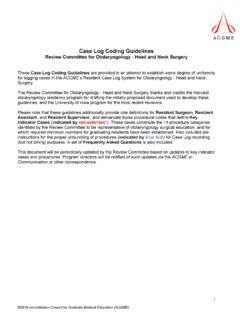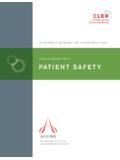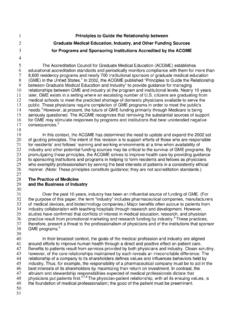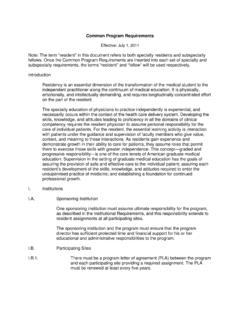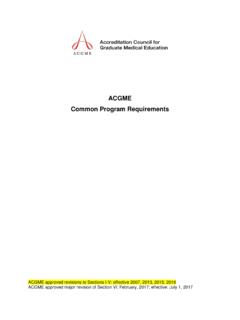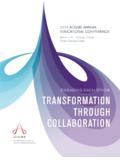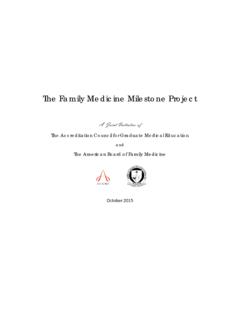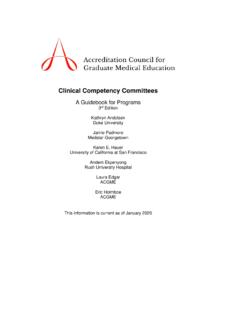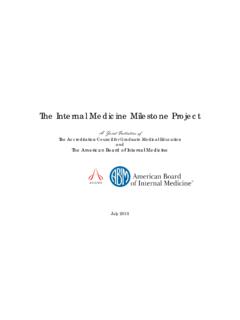Transcription of Family Medicine - ACGME
1 Specialty Specific Information Family Medicine Most Common Citations in Core Family Medicine Programs 1. The Education Program: Educational Program Patient Care Experience: FMC patient pop/visits; n=60 2. The Education Program: Educational Program Patient Care Experience: Maternity Care; n=45 3. Institutional Support: Institutional Support Sponsoring Institution; n=35 4. Prog Pers & Resources: Responsibilities of Program Director; n=25 5. The Education Program: Curricular Development Management of Health Systems; n=18 6. The Education Program: Service to Education Imbalance; n=18 Potential Challenges for Prospective THC s Applying for Accreditation Institutional Support: Internal review /Process/Midpoint Institutional Requirement : Internal reviews must be in process and documented in the GMEC minutes by approximately the midpoint of the accreditation cycle.
2 The accreditation cycle is calculated from the date of the meeting at which the final accreditation action was taken to the time of the next site visit. o Must a single residency institution conduct an internal review as specified in the institutional requirements? A single residency institution is expected to be in compliance with the Institutional Requirements but may have a modified version of a GMEC. The Committee must conduct an internal review mid way through the interval between site visits and should include representatives from other specialty areas and from administration. It should not include the program director and faculty of the program being reviewed, but they should be interviewed during the process. Since there are no other residencies in a single residency institution, resident membership on this committee is not required.
3 Formal minutes should be kept of the meeting at which the GMEC reviews the information and makes its conclusions. These must be discussed with the program director. If it is found that the program is not in compliance with the program requirements, it is the responsibility of the sponsoring institution to ensure that the program has the required resources to achieve compliance. The DIO must make sure that internal reviews are scheduled and take place as required. Documentation in the GMEC meeting minutes of date, attendees, etc. is important and will be verified by the site visitor. Sponsoring Institution/Educational and work Environment Institutional Program Requirement The Sponsoring Institution and its programs must provide an educational and work environment in which residents may raise and resolve issues without fear of intimidation or retaliation.
4 O NOTE: The suggested approach is to have a third party resolution process. Specialty Specific Information Participating Sites: Participating hospitals may not be at such a distance from the primary teaching sites that they require excessive travel time or otherwise fragment the educational experience. o NOTE: Undue travel may have a negative impact on the resident s education and safety, and patient care and safety, continuity of care, conference attendance and resident well being. Sites should be as close as possible to the primary hospital and FMC as possible. Resident Support Group: ).(1) Programs must have formal mechanisms specifically designed for promotion of physician well being and prevention of impairment.
5 There also should be a structured and facilitated group designed for resident support that meets on a regular basis. o NOTE: New programs should be aware of this program requirement. Faculty: The physician faculty must have current certification in the specialty by the American Board of Family Medicine , or possess qualifications acceptable to the review Committee. o NOTE: This is a very important to the FM RRC and very few exceptions are considered. ) Family physician faculty must have admitting privileges in the hospital(s) where the FMC patients are hospitalized. Programs should assess the skills and credentials of individual faculty to perform procedures and care for the types of problems they will be teaching the residents.
6 The professional skills of the teacher should always be documented as up to date and meeting the criteria for credentials and privileges of the primary hospital. o NOTE: Faculty members are expected to role model patient care in all settings including inpatient settings. Faculty Scholarly Activity: The faculty must establish and maintain an environment of inquiry and scholarship with an active research component. ) The faculty must regularly participate in organized clinical discussions, rounds, journal clubs, and conferences. ) Some members of the faculty should also demonstrate scholarship by one or more of the following: ).(1) peer reviewed funding; ).(2) publication of original research or review articles in peer reviewed journals, or chapters in textbooks; ).
7 (3) publication or presentation of case reports or clinical series at local, regional, or national professional and scientific society meetings; or, ).(4) participation in national committees or educational organizations. ) Faculty should encourage and support residents in scholarly activities. Specialty Specific Information o NOTE: Examples of scholarly activity include those mentioned above plus professional presentations beyond the local level and quality improvement or practice improvement projects. Scholarly activity cannot only be quality improvement projects. Faculty should aim for one type of scholarly activity each year. Make sure that faculty scholarly activity information in the PIF is consistent with information provided in faculty CVs.
8 Number of Faculty: Faculty/Resident Ratio o There must be a sufficient number of hours contributed by a critical mass of Family physician faculty to prevent fragmentation of the learning experience. In addition to the program director, there must be at least one full time equivalent (FTE) Family physician faculty for each six residents in the program. Any program in operation must have at least two Family physician faculty members, including the director, regardless of resident complement. By the time a program offers all three years of training with the required minimum number of resident positions ( , 4 4 4) at least one of the additional Family physician faculty must be full time. A full time commitment is at least 1400 hours per year devoted to the residency spent in resident administration, resident teaching, resident precepting and attending duties, exclusive of time spent in direct patient care without the presence of residents.
9 As the resident complement increases beyond the minimally acceptable size, additional full time Family physician faculty will be needed to provide a core group of Family physician faculty. Where part time faculty members are utilized, there must be evidence of sufficient continuity of teaching and supervision. ).(2).(c).(ii) Faculty Supervision o Whenever residents are performing clinical duties in the FMC, there must be an appropriate number of Family physician faculty who, without other obligations, are engaged in active teaching and supervision of the residents. The appropriate number of faculty must be determined in relation to the level of training of the residents, the number of patients being seen in a clinic session, and the competency of the residents.
10 In general, there should be at least one supervising Family physician faculty member who is freed of all other activities for every four residents working in the clinic at any given time. If only one resident is seeing patients in the FMC, a single faculty member may be engaged in other activities to a maximum of 50%, but the teaching and supervision of the resident must take priority. Faculty time involved with medical students and other learners under the faculty's clinical supervision should not dilute the supervision of residents. NOTE: It is very important that these faculty to resident ratios be met. FMC/FQHC/THC Criteria: ).(4) Programs that involve training in Community, Migrant Health Centers (C/MHCs) or Federally Qualified Health Centers (FQHC) must provide assurance that these facilities meet the Specialty Specific Information criteria for an FMC, as outlined below, unless an exception is approved by the review Committee.
